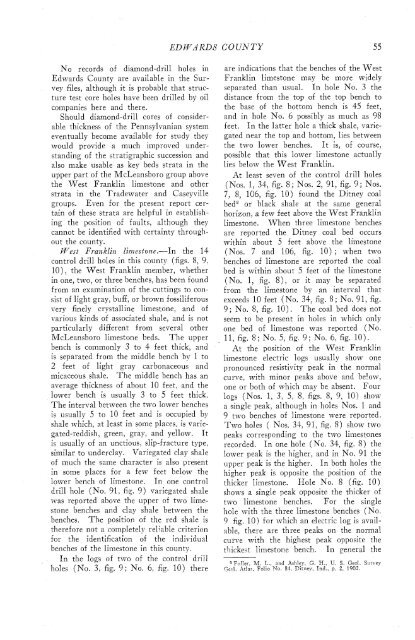subsurface geology and coal resources of the pennsylvanian system ...
subsurface geology and coal resources of the pennsylvanian system ...
subsurface geology and coal resources of the pennsylvanian system ...
You also want an ePaper? Increase the reach of your titles
YUMPU automatically turns print PDFs into web optimized ePapers that Google loves.
EDWARDS' COUNTY 55<br />
No records <strong>of</strong> diamond-drill holes in are indications that <strong>the</strong> benches <strong>of</strong> <strong>the</strong> West<br />
Edwards County are available in <strong>the</strong> Sur- Franklin limestone may be more widely<br />
vey files, although it is probable that struc- separated than usual. In hole No. 3 <strong>the</strong><br />
ture test core holes have been drilled by oil<br />
companies here <strong>and</strong> <strong>the</strong>re.<br />
Should diamond-drill cores <strong>of</strong> considerable<br />
thickness <strong>of</strong> <strong>the</strong> Pennsylvanian <strong>system</strong><br />
eventually become available for study <strong>the</strong>y<br />
distance from <strong>the</strong> top <strong>of</strong> <strong>the</strong> top bench to<br />
<strong>the</strong> base <strong>of</strong> <strong>the</strong> bottom bench is 45 feet,<br />
<strong>and</strong> in hole No. 6 possibly as much as 98<br />
feet. In <strong>the</strong> latter hole a thick shale, variegated<br />
near <strong>the</strong> top <strong>and</strong> bottom, lies between<br />
would provide a much improved under- <strong>the</strong> two lower benches. It is, <strong>of</strong> course,<br />
st<strong>and</strong>ing <strong>of</strong> <strong>the</strong> stratigraphic succession <strong>and</strong><br />
also make usable as key beds strata in <strong>the</strong><br />
possible that this lower limestone actually<br />
lies below <strong>the</strong> West Franklin.<br />
upper part <strong>of</strong> <strong>the</strong> McLeansboro group above At least seven <strong>of</strong> <strong>the</strong> control drill holes<br />
<strong>the</strong> West Franklin limestone <strong>and</strong> o<strong>the</strong>r (]hTos. 1, 34, fig. 8; Nos. 2, 91, fig. 9; Nos.<br />
strata in <strong>the</strong> Tradewater <strong>and</strong> Caseyville 7, 8, 106, fig. 10) found <strong>the</strong> Ditney <strong>coal</strong><br />
groups. Even for <strong>the</strong> present report cer- bed3 or black shale at <strong>the</strong> same general<br />
tain <strong>of</strong> <strong>the</strong>se strata are helpful in establish- horizon, a few feet above <strong>the</strong> West Franklin<br />
ing <strong>the</strong> position <strong>of</strong> faults, although <strong>the</strong>y<br />
cannot be identified with certainty throughout<br />
<strong>the</strong> county.<br />
limestone. When three limestone benches<br />
West Franklin limestone.-In <strong>the</strong> 14<br />
control drill holes in this county (figs. 8, 9.<br />
lo), <strong>the</strong> West Franklin member, whe<strong>the</strong>r<br />
in one, two, or three benches, has been found<br />
from an examination <strong>of</strong> <strong>the</strong> cuttings to consist<br />
<strong>of</strong> light gray, buff, or brown fossiliferous<br />
very finely crystalline limestone, <strong>and</strong> <strong>of</strong><br />
various kinds <strong>of</strong> associated shale, <strong>and</strong> is not<br />
particularly different from several o<strong>the</strong>r<br />
McLeansboro limestone beds.<br />
The upper<br />
bench is commonly 3 to 4 feet thick, <strong>and</strong><br />
is separated from <strong>the</strong> middle bench by 1 to<br />
2 feet <strong>of</strong> light gray carbonaceous <strong>and</strong><br />
micaceous shale. The middle bench has an<br />
average thickness <strong>of</strong> about 10 feet, <strong>and</strong> <strong>the</strong><br />
lower bench is usually 3 to 5 feet thick.<br />
The interval between <strong>the</strong> two lower benches<br />
is usually 5 to 10 feet <strong>and</strong> is occupied by<br />
shale which, at least in some places, is variegated-reddish,<br />
green, gray, <strong>and</strong> ello ow. It<br />
is usually <strong>of</strong> an unctious, slip-fracture type,<br />
similar to underclay. Variegated clay shale<br />
<strong>of</strong> much <strong>the</strong> same character is also present<br />
in some places for a few feet below <strong>the</strong><br />
lower bench <strong>of</strong> limestone. In one control<br />
drill hole (No. 91, fig. 9) variegated shale<br />
was reported above <strong>the</strong> upper <strong>of</strong> two limestone<br />
benches <strong>and</strong> clay shale between <strong>the</strong><br />
benches, The position <strong>of</strong> <strong>the</strong> red shale is<br />
<strong>the</strong>refore not a completely reliable criterion<br />
for <strong>the</strong> identification <strong>of</strong> <strong>the</strong> individual<br />
benches <strong>of</strong> <strong>the</strong> limestone in this county.<br />
In <strong>the</strong> logs <strong>of</strong> ts~7o <strong>of</strong> <strong>the</strong> control drill<br />
holes (No. 3, fig. 9; No. 6, fig. 10) <strong>the</strong>re<br />
are reported <strong>the</strong> Ditney <strong>coal</strong> bed occurs<br />
within about 5 feet above <strong>the</strong> limestone<br />
(Nos. 7 <strong>and</strong> 106, fig. 10) ; when two<br />
benches <strong>of</strong> limestone are reported <strong>the</strong> <strong>coal</strong><br />
bed is within about 5 feet <strong>of</strong> <strong>the</strong> limestone<br />
(No. I, fig. 8), or it may be separated<br />
from <strong>the</strong> limestone by an interval that<br />
exceeds 10 feet (No. 31, fig. 8 ; No. 91, fig.<br />
9; No. 8, fig. 10). The <strong>coal</strong> bed does not<br />
seem to be present in holes in which only<br />
one bed <strong>of</strong> limestone was reported (No.<br />
11, fig. 8; No. 5, fig, 9; No. 6, fig. 10).<br />
At <strong>the</strong> position <strong>of</strong> <strong>the</strong> West Franklin<br />
limestone electric logs usually show one<br />
pronounced resistivity peak in <strong>the</strong> normal<br />
curve, with minor peaks above <strong>and</strong> be!ow,<br />
one or both <strong>of</strong> which may be absent. Four<br />
logs (Nos. 1, 3, 5, 8, figs. 8, 9, 10) show<br />
a single peak, although in holes Nos. 1 <strong>and</strong><br />
9 two benches <strong>of</strong> limestone were reported.<br />
Two holes ( Nos. 34, 91, fig. 8) show two<br />
peaks corresponding to <strong>the</strong> two limestones<br />
recorded. In one hole (No. 34, fig. 8) <strong>the</strong><br />
lower peak is <strong>the</strong> higher, <strong>and</strong> in No. 91 <strong>the</strong><br />
upper peak is <strong>the</strong> higher. In both holes <strong>the</strong><br />
higher peak is opposite <strong>the</strong> position <strong>of</strong> <strong>the</strong><br />
thicker limestone. Hole No. 8 (fiy. 10)<br />
shows a single peak opposite <strong>the</strong> thicker <strong>of</strong><br />
two limestone benches. For <strong>the</strong> single<br />
hole with <strong>the</strong> three limestone benches (No.<br />
9 fig. 10) for which an electric lo,g is available,<br />
<strong>the</strong>re are three peaks on <strong>the</strong> normal<br />
curve with <strong>the</strong> highest peak opposite <strong>the</strong><br />
thickest limestone bench. In general <strong>the</strong><br />
V~ulIer, 14. L., <strong>and</strong> Ashley, G. H., U. S. Geol. Survey<br />
Genl, Atlas, Folio No. 81. Ditney, Ind., p. 2. 1902.
















